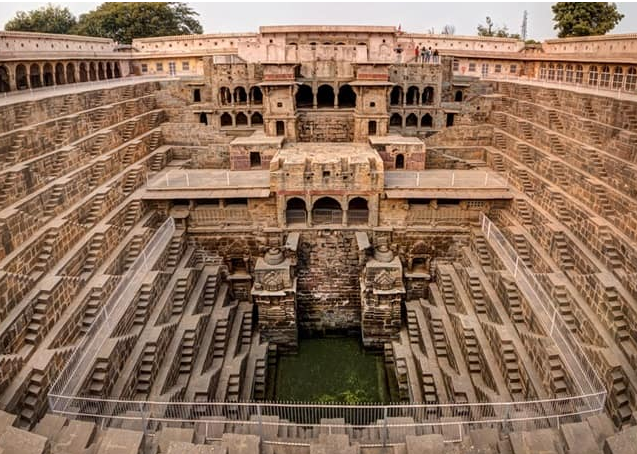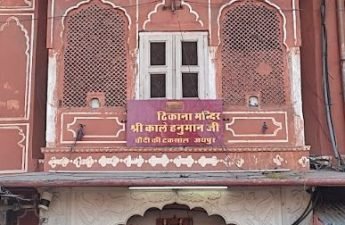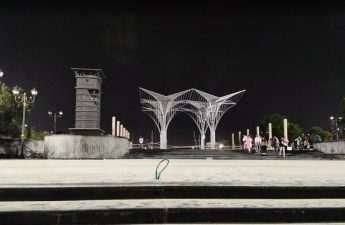Abhaneri Chand Bawdi (Jaipur stepwell), bandikui, Rajasthan is a major tourist attraction in the village of Abhaneri. It is known as Jaipur stepwell. It is located in the Dausa district near Jaipur, Rajasthan which holds memories of the history of the 9th century.
Table of Contents
Chand Baori Facts
In this article, we are going to tell about Abhaneri Chand Bawdi Jaipur Stepwell Story. It is for those who are fond of travel as well as architecture lovers who are fond of knowing the history of a place.
Abhaneri Chand Bawdi Jaipur Stepwell is located in the Dausa district of Rajasthan.
Abhaneri is a small village which is situated in the Dausa district near Jaipur in Rajasthan and Chand Bawri is build in this village. Chand Baori of Abhaneri is a square step well with steps on three sides, which serve to store water.
This Jaipur stepwell was built by “Raja Mihir Bhoj” of the Nikumbha dynasty Who was also know as “Chand” after him. The name of this stepwell was “Chand Baori”.
It is says that this stepwell has been build by ghosts and this step is so deep that if any object falls in it, it is impossible to get it back. This stepwell is more than 1000 years old, but even today this step well remains the same as before.
This beautiful and wonderful structure of Chand Baori of Abhaneri is not used like this today, but it is the most attractive stepwell in the world and attracts tourists from all over the world. That is why it is look after by the Archaeological Survey of India.
Due to the world’s most attractive stepwell and amazing structure, many films have also been shot here, including Bhool Bhulaiyaa, Best Exotic Hotel Marigold, The Fall, and The Dark Knight Rises.
If you must read this article to know other information about Abhaneri Chand Bawdi Jaipur Stepwell.
Chand Baori Haunted History

Chand Baori stepwell Abhaneri – This stepwell (Jaipur stepwell) was built by “Raja Mihir Bhoj” of the Nikumbha dynasty who was also known as “Chand” and after him, the name of this stepwell was named Chand Baori. It has been more than 1000 years since this stepwell was built.
Raja Chand had built it so that the local people could get clean water throughout the year, but according to the local people of Abhaneri, it was believed that this Baori was built by jinns and ghosts because of the construction of this Baori was only one. It was done at night which is an impossible task in every way.
Apart from this, this stepwell is also known as a meeting place for the local people of Abhaneri as the temperature of this step well cools down to 7-8 degrees during summers due to which the lower parts of the stairs are also cold. becomes. Due to this, the local people of Abhaneri used to sit around the well.
Apart from the general uses, according to Hindu mythological beliefs and legends, the water of this step well (Chand Baori) serves as the boundary between heaven and earth. Hence it has now become a holy place for meditation, prayer, and also for religious work, and bathing.
Because of this, it has now become a holy place for meditation, prayer, and also for religious bathing. One must visit here before going to Harshat Mata Temple.
Chand Baori Stepwell Architecture

Chand Baori is known for the splendid architectural expertise of Indian architects. It is constructed in a square shape. Stairs are made in geometric shapes on the three walls of this 19.5-meter deep stepwell. Instead of climbing these stairs directly, climb from one side.
This 13-story Chand Baori of Abhaneri is more than 100 feet deep and about 35 meters wide from all sides. In this Baori, more than 3500 steps are made in the form of a maze, which is an architectural marvel.
Seeing these stairs made in the form of a labyrinth, it seems that even if we want to come down from the stairs, we will not be able to come back up from those stairs.
Abhaneri Chand Bawdi Jaipur Stepwell is surrounded by a high and strong boundary wall and a corridor is built in front of it. This boundary wall and entrance gate were not part of the original plan of this well. These have been made later by the Archaeological Survey of India.
Many artifacts are kept in Abhaneri Chand Bawdi Jaipur Stepwell corridor-
- Shiva’s head made of red stone
- Statue of meditating Shiva and Shiva-Parvati
- Statue of Vishnu and Parashurama in Kalki Avatar
- Kartikeya, Lakshmi ji statue
- The finely carved Mahishasurmardini
- The panels of Brahma, Vishnu, and Mahesh
- Harshat (Harsiddhi) Mother
- Jain Idols and Yakshas
- attractive engraved pillar
It is believed that the lower part of the stairs of Chand Baori was built in the 8th to 9th century while the upper part of the stairs was complete in the 18th century during the Mughal Shashan period.
Harshat Mata Temple – Abhaneri Festival
At a distance of about 100 meters on the western side of Chand Baori, there is a temple of Harshat Mata in the shape of a dome. People also call Harshat Mata Harsiddhi Mata and she is considered to be the goddess of joy and happiness. Shakti Puja is performed here on the occasion of Navratri.
A 3-day (annual) Abhaneri Mahotsav is organized in Abhaneri village every Sharad Navratri. This festival is organized every year 10 days before Dussehra or 30 days before Deepawali.
On this occasion of the festival, this Chand Baori remains open for the tourists for three days and a jump competition is organized for the youth of the village. During the rest of the time, it is not allowed to descend on the steps of Chand Baori.
Other Attractions Tourist Places To Visit Near Abhaneri Chand Bawdi Jaipur Stepwell
Madhogarh Fort
Madhogarh Fort is situate on the top of the hill which was build by the Raja of Jaipur- Madhav Singh. It is an ancient fort that has now been convert into a royal hotel.
Bhandarej
Bhandrej is located on the Jaipur-Agra highway, about 65 km from Jaipur. Bhandrej is at a distance of about 10 km from Dausa.
During the Mahabharata period, Bhandarej was know as Bhadramati. Sculptures, decorative latticework, lattices, walls, terracotta utensils, etc. have been find during the excavation here, due to which its antiquity can be easily estimate.
Bhandarej Bauri and Bhadravati Palace are two popular places in Bhandarej.
Mehandipur Balaji Temple
Mehandipur Balaji Temple is a Hindu temple dedicate to Hanuman Ji and in front of his temple there is a temple dedicate to Siyapati Rama in which the idol of Ramchandra Ji is install.
This temple is so popular that every year lakhs of devotees come here from far and wide cities and states to visit Balaji.
Devotees visiting Mehandipur Balaji Temple offer Boondi laddus to Balaji and urad dal and rice to Bhairav Baba, who helps them to get rid of evil spirits and ghosts. Tuesday and Saturday are the most special days to visit Balaji. These days it is most crowded here.
Jhajirampura
Jhajirampura is also famous for having a natural water tank as well as temples of Rudra (Shiva), Balaji (Hanuman), and other deities. It is situate towards Bandikui (Basava), about 45 km from the district headquarter.
Bandikui
Bandikui is located at a distance of about 35 km from Dausa. The Roman-style church here is a popular attraction for Protestant Christians.
Lotwara
Lotwara village is located just 11 km from Abhaneri and 110 km from Jaipur. The main attraction of this village is the Lotwara Garh (Fort), which was build by Thakur Ganga Singh in the 17th century.
Chand Bawdi Address –
Chand Baori Location – Near Harshat Mata Temple, Abhaneri, Bandikui, Rajasthan 303326
Chand Bawdi Timings
Timings – 7:30 am to 5:00 pm
Abhaneri Stepwell Entry Fee
Indian Tourist Fee – Rs.50/- and Foreign Tourist Fee – Rs.200/-
Best time to visit Chand Baori
The best time to visit Chand Baori is from October to March as the day temperature is less and the nights are cooler due to less sunlight.
How to reach Abhaneri Stepwell Jaipur
Abhaneri Chand Baori is located in Dausa district, 95 km from Jaipur city of Rajasthan. If you want to go here from Delhi or Jaipur, then the best option is to hire a car from Delhi or Jaipur. Because Delhi and Jaipur are the major airports of India.
How to reach Abhaneri Chand Bawdi by Air
Jaipur and Delhi are the nearest airports to Abhaneri Chand Bawdi. You can come here by flight from any corner of the country. After arriving at the airport, one can hire a taxi or cab to reach Abhaneri.
How To Reach Jaipur Stepwell By Rail
If you want to travel by rail, then the nearest railway station is Abhaneri in Jaipur. For this, you can reach here by catching a train from all the major stations of the country.
How to reach Chand baori AbhaNeri by Road
If you want to go to Chand Baori Abhaneri by road then you can travel here by bus and taxi for that. If you want to come here by driving your own vehicle then you can easily come because Abhaneri Chand Bawri is connect to NH-11.
read this article Needle Man Arun Bajaj, Rajasthani Traditional Dress
FAQs
1. What was the original purpose of building Abhaneri Stepwell Jaipur?
Due to the dry area of Abhaneri, the problem of water has been a major reason here. So the original purpose of building this stepwell was to store water.
2. What is Abhaneri Festival or Festival?
A 3-day (annual) Abhaneri Mahotsav (festival) is organize in Abhaneri village every Sharad Navratri. This festival is organize every year 10 days before Dussehra or 30 days before Deepawali.
3. Who built Chand Baori and why?
This stepwell was build by “Raja Mihir Bhoj” of the Nikumbha dynasty who was also know as “Chand”. The original purpose of building Chand Baori was to store water.
4. How many steps are there in Abhaneri Chand Bawdi Jaipur Stepwell?
Abhaneri Stepwell has more than 3500 steps made in the form of a maze which is an architectural marvel.
5. Which is the deepest stepwell in the world?
Chand Baori of Abhaneri is the deepest stepwell in the world.
6. How far is Abhaneri Step Well from Jaipur?
Abhaneri Chand Bawdi Jaipur Stepwell is located in Dausa district, Rajasthan, located at a distance of (93.2 km) via NH21 and (123.6 km) via NH148 from Jaipur city.
7. How to reach Abhaneri?
Abhaneri Chand Baori is located in Dausa district, 95 km from Jaipur city of Rajasthan. If you want to go here from Delhi or Jaipur, then the best option is to hire a car from Delhi or Jaipur. Because Delhi and Jaipur are the major airports of India.
8. How to reach Chand Baori?
Abhaneri Chand Baori is located in Dausa district, 95 km from Jaipur city of Rajasthan. If you want to go here from Delhi or Jaipur, then the best option is to hire a car from Delhi or Jaipur. Because Delhi and Jaipur are the major airports of India.
If you are from Jaipur or any nearby city of Jaipur then Chand Baori can only be reach by road. Abhaneri village is near Jaipur. It is easily accessible from Jaipur-Agra Highway.
9. Why is it called a stepwell?
It is constructed in a square shape. There are steps in geometric shape on the three walls of this 19.5-meter deep stepwell, which help in the flow of water to the bottom. That’s why it is call stepwell.
10. Where is Chand Baori located in Rajasthan?
Abhaneri Chand Baori is located in Dausa district, 95 km from Jaipur city of Rajasthan.
11. What is Chand Baori famous for?
Chand Baori is know for the splendid architectural expertise of Indian architects. It is construct in a square shape. Stairs are made in geometric shape on three walls of this 19.5-meter deep stepwell.
Seeing these stairs made in the form of a labyrinth, it seems that even if we want to come down from the stairs, we will not be able to come back up from those stairs.
12. What is the reason for the fame of Chand Baori?
Chand Baori is knowing for the splendid architectural expertise of Indian architects. It is construct in a square shape. Stairs are made in geometric shape on three walls of this 19.5-meter deep stepwell.
Seeing these stairs made in the form of a labyrinth, it seems that even if we want to come down from the stairs, we will not be able to come back up from those stairs.
13. What is the depth of Chand Baori?
This 13-story Chand Baori of Abhaneri is more than 100 feet deep and about 35 meters wide from all sides.



